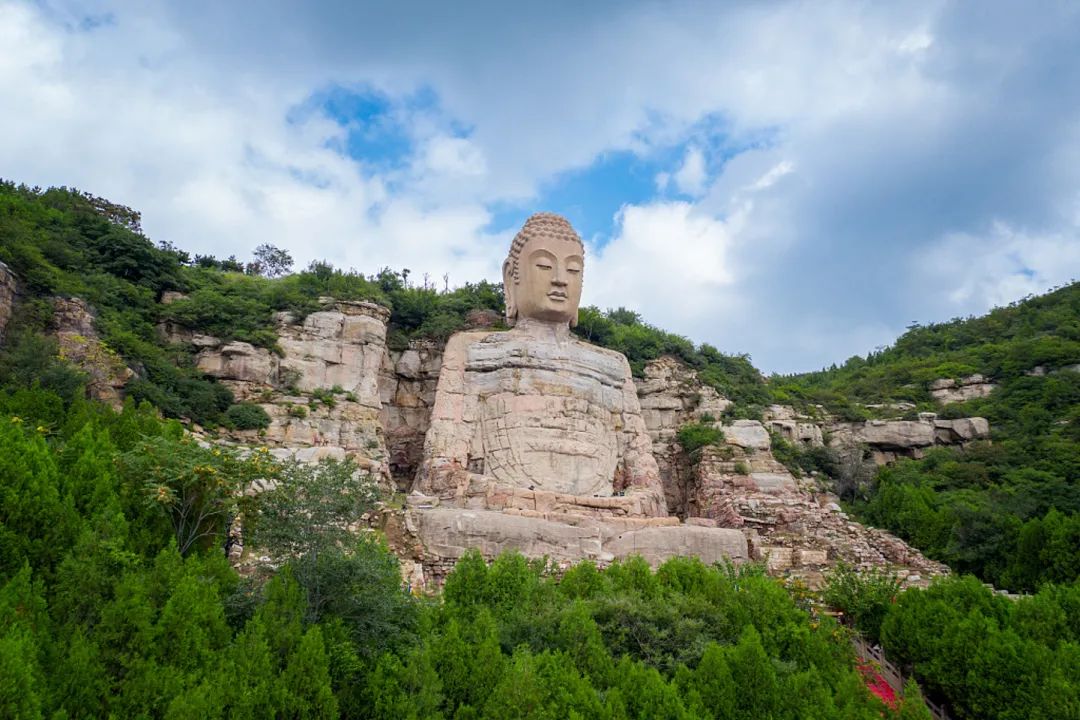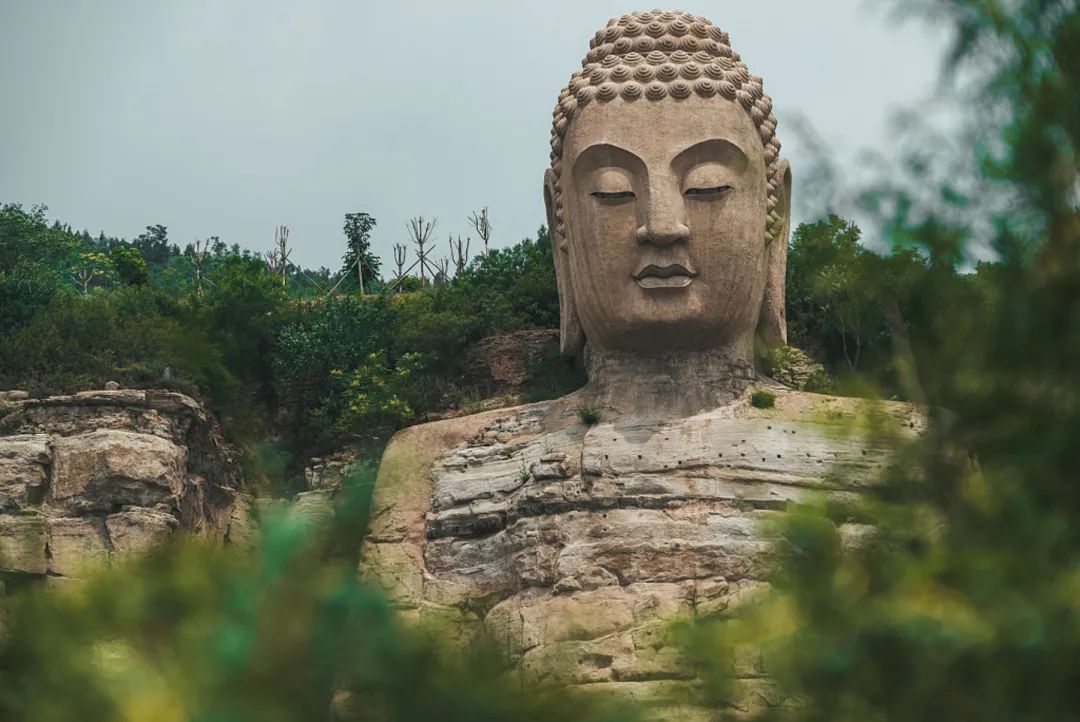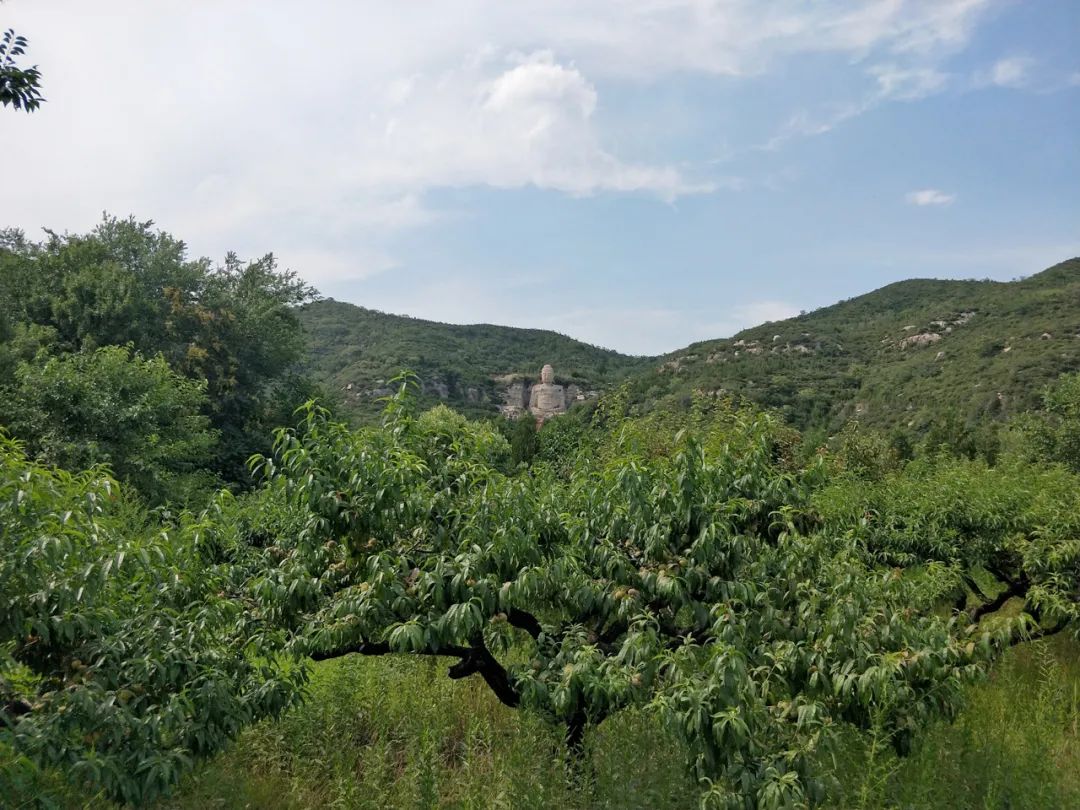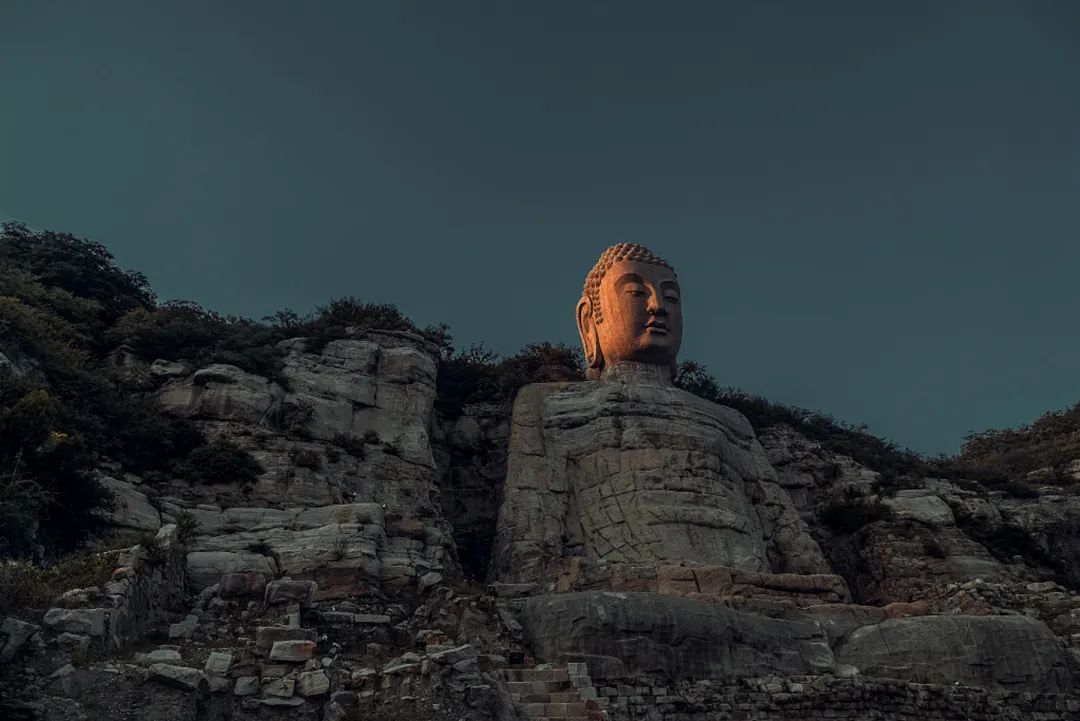"Jinyuanmei" Mengshan: The largest Buddha legend in the Northern and Southern Dynasties
Author:Fairview Taiyuan City Time:2022.06.29
"Telle Chuan, under the mountains"
In the eighteenth year of the Northern Wei Dynasty (494 years), after Emperor Xiaowen Tuoba Hong (Han Ming Yuanhong) moved to Luoyang, Wuzhou Mountain in the west of the old capital (now Shanxi) was deserted. The 34 -year -old Yungang Grottoes stopped the large -scale creation and turned to the construction of the small cave. At the same time, on the cliff on the west bank of the River in Luoyang, the sound of the ax was jingling ... Two years later, Gao Huan was born in the home of a soldier in Huaishuo (now Guyang, Inner Mongolia). On the spot, he will become the actual terminator of the Northern Wei Dynasty.
At that time, Huai Shuo was a military town on the border of the northern Wei Dynasty, and other Wo Ye (now Northeast Northeast of Inner Mongolia), Wugawa (now Western Wudawa in Inner Mongolia), Fu Ming (now Southeast of the Fourth Son of Inner Mongolia), Rou Xuan (Rouxuan Inner Mongolia Xing and Northwest), Huaihuang (now Zhangbei, Hebei), also known as six towns, stationed in a large number of Xianbei and highly alive military and civilians. The ears are dreamed, and the Han people of the ancestors of the Bohai Sea (now Hebei) Gao Huan were assimilated, and even a Xianbei name was: He Liuhun.
If you do n’t marry Lou Zhaojun, a beautiful woman, Gao Huan, who is “long head and white, teeth is white like jade”, may be just a good weed on the grassland. A horse in the dowry, Gao Huan was the master of the team, and there were hundreds of people. At this time, after the reform of Emperor Xiaowen, the Xianbei nobles in Luoyang City had been completely sinicized, but the military and civilians of the six town were still the same, and the two classes were severely torn. In the four years of Zhengguang (523), the military and civilians in the six town fell sharply, and the troops rebelled. Gao Huan waited for the opportunity, and successively attached Du Luo Zhou, Ge Rong, Er Zhu Rong and others, sitting quickly. Nine years later, Gao Huan entered Luoyang, supported Emperor Xiaowu Yuan Xiu, and served as the prime minister, "the emperor to order the princes." In the three years of Yongxi (534 years), Yuan Xiu, who was unwilling to be a puppet, failed, fled to Changan. Soon, he was poisoned by another minister Yu Wentai. Gao Huan supports the family of Yuan Shan as Emperor Xianshan, and moved to the capital (now Linzhang, Hebei). The following year, Yu Wentai helped the royal family Yuanbao's throne, and it was called the Western Wei Dynasty in history.
The Eastern and Western Wei Dynasty all looked at orthodox and fight each other. In the fourth year of Wu Ding (546 years), Gao Huan siege the West Wei Yuyu (now Shanxi County). For more than 50 days with thousands of soldiers and thousands of defenders, the city did not break, but lost more than 70,000 people. Gao Huan was angry, but was rumored to die. In order to make a rumor, Gao Huan set up a banquet on the way to retreat. During the banquet, he ordered General Dendment to sing "The Song of the Lele" -the "Shou Show" recorded in the historical record: "敕 Lechuan, under the mountains. The wind blows the grass and the cattle and sheep. "At that time, the Lichechuan refers to the places where the three south south of the mountains and the mountains and the north and south of the Yin Mountains were stationed. The singing voice is vast and sad.

After the restoration, the Mengshan Buddha saw the sun again. (Visual China/Picture)
From Battlefield to Better
In the first month of the following year, Gao Huan died. The eldest son Gao Cheng took over the power, defeated Hou Jing, and forced him to rely on Nanliang. Soon, Hou Jingzhi's chaos broke out, and Gao Cheng took the opportunity to annex the territory of Nanliang and Henan. As a result, Gao Chengfeng Qi Qi. But he was not satisfied, and he hit the idea of being the emperor. In August of the seventh year of Wu Ding (549), everything was ready. On the eve of ascending the throne, Gao Cheng dreamed that he was assassinated by Lan Jing (that is, a chef). The next day, the nightmare became true. He died under Lan Jingdao at the age of 29. His most famous son, Gao Changgong, who later seal "Lanling King" is only 6 years old.
It was unexpected that Gao Yang, 5 years younger than Gao Cheng. In the family, Gao Yang's appearance is not amazing, but it is a typical "ruthless character". One day when I was young, Gao Huan took out the chaos and let his sons deal with it. The sons were in a hurry, but Gao Yang "pumped the knife and cut it", saying: "Those who are chaotic must be cut." The allusion "fast knife cuts chaos" is out of this.
In May of the eighth year of Wu Ding (550), Gao Pujou led 100,000 family soldiers to accept the "Zen Jean" of Emperor Xiao Jing, changed Yuan Tianbao, and Qi Qi. In order to distinguish Xiao Qi in the Southern Dynasties, it is called Beiqi. Seven years later, Chen Ba first established the Nanliang of the Nanliang, and Dingdu Jiankang (now Nanjing), known as Nan Chen in history; Yuwentai's three sons Yu Wenjue abolished Emperor Wei Gong of the West, changed the country, and founded Chang'an.
Under Gao Yangzhi, the north of the north hit Kuromo, the northeast of Khitan, the northwest Poorran, the Hui Huainan in the north, and the south, the territory of the Northern Inner Mongolia Plateau, the south to the Yangtze River, the west to the Yellow River, and the sea east to the sea. The farmers, salt and iron, and ceramics in the territory are prosperous, and their national strength was strong, surpassing South Chen and Northern Zhou Dynasty.
What is interesting is that although the Northern Qi dynasty is the city, Gao Yang, including his previous father and brother, and the later emperors, are more willing to move Jinyang, most of them are either born or died. In this reason, Gao Yangyun said: "The hegemony is located, the king is the foundation." However, the inspection of the roots depends on the special geography of Jinyang.
During the Northern and Southern Dynasties, Jinyang was located in Jinyuan District, Taiyuan City, Shanxi Province. From the perspective of the big situation, there are Taihang in the east of Shanxi, Lu Liang in the west, Hengshan in the north, and the middle of the south, there are the Yellow River surrounded by the Yellow River, and the Fenhe River runs through. Guan Yan, Nanzha Taiyue. No wonder, in the first year of the Northern Wei Dynasty (532), when Gao Huan expelled Er Zhu Rong's adopted son, Zhu Zhao, lamented the four plugs in the Jinyang Department, "Jianjian Datai's Prime Minister's Mansion settled", and opened the Gao's remote control mode. This model was first created by Cao Cao in the late Eastern Han Dynasty and was called "Battlefield" or "Battlestick" by later historians.
It was from this year that the mountains outside the Jinyang City and the Taihang Dao Dao of Tancheng have been lively -Gao's effectively imitated the northern Wei royal family in Da Di Buddhism, and constructing temple chisels. Its intentions are nothing more than praying for God and Buddha. "Four Eighty Temples in the Southern Dynasties", why do you give it too much? Today, the well -known Taiyuan Tianlongshan Grottoes and Handan Xiangtang Mountain Grottoes are all created by Gao Huan. As well as Gao Yang, the wind of worshiping God is getting stronger. I have not said twice, and also support the monk and nuns of the 1/3 of the state treasury. At that time, Jinyang had been promoted to other capitals, and Gao Yang's "crazy" increased the former temple such as Tang Shuyu Temple (now Taiyuan Jin Temple), and also looked at Mengshan at an altitude of 1325 meters. The cliffstone tower. A more "crazy" idea has emerged, and Gao Yang has to chine the mountains as a Buddha -a big Buddha who has never seen the people in the world that is far away from Yungang Grottoes.
After the restoration, the Mengshan Buddha saw the sun again. (Visual China/Picture)

Song Dynasty Lianli Tower
After more than 1,400 years, a summer afternoon, I switched to Mengshan several times. Judging from the parking lot with several cars, it is obviously not hot enough, although the introduction has been open for more than ten years.
After the epidemic prevention disinfection and fire security check, I went to a ancient stone bridge. It is said that it was built in the Tang Dynasty and ushered in the scenes of Tang Gaozong Li Zhi and Queen Wu Zetian, Queen Tang Taizu Li Ke, Hou Han Gaozu Liu Zhiyuan, and Emperor Liu Jiyuan of the Northern Han Dynasty. However, the bridge logo confused their order of "singing".
With the column, the colorful flowers and plants were looking at the water flowing water, and the mountains of the mountains were running back.意 is a local dialect, which means that the top of the loess is flat and the slope is steep. No matter how far, I saw the winding and rolling Xishan north and south. At the time of Jin Yuan, the famous literati Yuan Hao asked poems: "The west mountains on the water are like hanging the screen, and the depression is thirty miles." In the poem, the "Xishan" refers to the Hangshan Mountain back. In fact, more than a dozen branches and remaining veins in the east of the western part of Taiyuan and the middle of the Luliang Mountains can be collectively referred to as Xishan; Mengshan, Xuanxian Mountain, and Tianlongshan are just one of them. After the Grand Buddha of Mengshan was excavated, it was called Xishan Grand Buddha in a long period of time.
Well up the cement road along the mountains and rivers, and occasionally staggered with several empty tourist vehicles. In a attraction that was changed from the bottom of the youth, my southerner returned to see the cave -earth kiln and brick kiln. The earth kiln is not unusual, punching on the wall, the kind of cave of Yan'an, which is often performed by film and television. The brick kiln is not a furnace kiln burning bricks, but a brick -built flat house. The appearance structure imitates the earth kiln. The wall and the top are very thick. In addition, the door can be opened in the room to improve the air circulation, and the top of the kiln can be used as the sun.
Tour the caves, the soles of the feet were replaced with a trail of the stone, and the slope was like a while, as if it was constantly tightening the clockwork. Finally, I climbed a stack of steep stairs and turned into a platform. It was suddenly cheerful in front of me, a large number of peach forests and dense and green. If you come one month earlier, you will be able to enjoy the beauty of "Fangfei in April in the world, and the peach blossoms in the mountains." Now, between branches and leaves, the fruits of quiet grouting are hiding. The mountain temple revealed a red wall in Tao Lin's head.
The name of the mountain temple is open. It is said that it was founded in the eleventh year of Yongping in the Eastern Han Dynasty (68 years). It is often called the Dawan Temple of the state (the ancient place name is the ancient place of the state, and today Inner Mongolia, Shanxi, and some areas of Hebei) are also the initial dojo of the Buddhist East China Chuanzhong as the Bailima Temple in Luoyang. During Gao Huan's "auxiliary government", Emperor Xiaojing ordered the famous monk who was known as the "gods" to live in, and Xuanfo Hongfa. In the second year of Tianbao (551 years), Gao Yang's decision expansion was expanded, and the amount was opened. Because of the Buddhist Pure Land Zongzong, who was later stationed in the Tang Dynasty as a master because of Hui Yan and Dao Chuo in the Tang Dynasty, Kaihua Temple "appeared for a while." In the four years of Taiping Xingguo (979) in the Northern Song Dynasty, Jinyang City was razed to the ground. After three years, a new city was built in Tangming Town (now southwest of Taiyuan City), and Kaihua Temple was built to cover the hearts of the people. As a result, Taiyuan had two Kaihua Temple, one in the mountain, called the upper courtyard; a city, called the courtyard. The prosperity of the incense of Si Shi can be seen. After the lower courtyard was renamed the business market in the early years of the Republic of China, only one road name was "Kaihua Temple Street"; the upper court was destroyed in the end of the Yuan Dynasty.
The gate of Kaihua Temple was closed strictly. I knocked and pushed it again without any response. I stopped and returned, but saw two mottled old tower brakes drilling from the left and rear and treetops ... actually made me feel mysterious, stunning, worship.
This is the Sari Tower in the hospital period. It was built in the first year of Chunhua in the Northern Song Dynasty (990), and it was more than a hundred years in the morning than Angkor Wat. Paste the fence and look carefully: the tower is divided into north and south, 8 meters high, and stands in a diamond seat with a thickness of more than 3 meters, so it is called Lianli Tower. Both towers are brick -building with the same structure. The front of the front is a semi -circular door arch, a flame -shaped voucher, hidden rolling grass and petals, and the remaining three -sided carved fake door. The tower eaves are stacked, up to 11 layers. The tower brake is beautiful, both like a magnified Shakya fruit, but also like many flying birds who are competing for the nest ...
Walking around the tower, I overlooking the northwest. In addition to more than a thousand meters, the green mountains are picturesque, and there is a mustard in the painting.
Overlooking the Mengshan Great Buddha from Kaihua Temple (Pang Mian/Picture)

Buddha's past
Ten years of Tianbao (that is, 559 years, there are many sayings created by the Great Buddha. This is the one who said from the same time). They rushed into the sky, overlooking the creeping team in the mountains in the mountains. These high -profile transfer of stone workers, carved workers, plastic workers, painters, carpentters, people ... set up sheds along the stream, "barrier stone for stoves, cut firewood as salary", began to "cut the stone all day and night," It is carved on the mountain. " However, Gao Yang couldn't wait for the big Buddha. In the tenth day of October of the year, he "self -contained", Shen Yanjiu, "collapsed in Jinyang". The glory and degeneration of life stopped abruptly. After that, the North Qi changed the three emperors like a horse lantern. The creation of the Great Buddha was also intermittent, until the five years (569 years), which was reigned by Gao Yang's nephew and the post -Lord Gaowei, was completed. Gao Wei, who is luxurious and luxurious, "fuel fuel", the flames of Dadan all night illuminated the Jinyang City 20 miles away, but could not illuminate the national movement of the wind and rain. After Gao Wei successively killed the famous general Deu Guang (the son of Dendu's gold) and Gao Changgong, Beiqi basically lost his ability to fight against North Zhou.
In October of the seventh year of Wu Ping (576), Emperor Wuwen, Emperor Wu of the Northern Zhou Dynasty led a army to start from Chang'an, and passed the Yellow River from the north bank of the Weiji River (now Shanxi Yongji West), and then passed through the jade of the Fenqu (now the southwestern Fen Fen Fen, Shanxi, Water bending), besieging Pingyang (now Linfen, Shanxi). At this time, Gao Wei was hunting in Guan Yushan with his concubine Feng Xiaoli. The urgent document came three even in the morning, but no one dared to play. Late to the sun, Gao Weifang Zhi Zhiyang failed, and wanted to return to Jinyang to lead his soldiers. Feng Xiaoli asked "to kill a siege more", and Gao Wei actually agreed. "Qiao Xiao knows how many rivals, and the city is the most in Rongyi. Jinyang has been recalled, and invite the king to hunt for a surround." Pingyang is Jinyang. As for the famous sentence in "One of the Northern Qi", "Xiao Lian Jade Body Heng Chen Ye has been reported to Zhou Shi into Jinyang", there is no record of Zhengshi, and it is largely from the beautiful imagination of the poet.
More than two months later, the Buddha saw the fire and wolf of "Zhou Shi entered Jinyang". For more than a month, Zhou Shi entered Wucheng. The members of the royal family were all captured during the fleeing, and the Northern Qi was destroyed.
Four years later, Yang Jian, who thought of the reincarnation of Ayuro King, usurped Zhou Li Sui, abolished Yuwen's movement, and advocated Buddhism. In the first year of Renshou (601), Yang Jian's son Han Wang Yang Hui "made the big pavilion and worshiped the statue", and the Mengshan Grand Buddha had a Buddhist porcela that covered the wind and rain. In the five years of Tang Xianqing (660 years), Li Zhi and Wu Zetian Lin Xinghua Temple, "Viewing and seeing" the Great Buddha of Tang Ru (about 61 meters today). In addition to "sighing the goblin", "big house treasures, property, clothes" also made local officials "solemn and solemn to decorate the holy capacity, and entrust the front place." In this year, Li Zhi intends to let Wu Zetian participate in political affairs. In the next three years, every autumn, on the official road of the Fenhe River, the eunuchs of the inner court will send the figure of the Great Buddha. At that time, it was 140 years before the birth of the Big Buddha in Sichuan. The first status of the Mengshan Great Buddha is still unprepared.
When the 71 -meter -high Leshan Great Buddha was completed and Tang Xianzong welcomed the bones in Chang'an, Buddhism reached its peak in the Tang Dynasty. The peak often means turning. Tang Wuzong, who believes in Taoism -Li Shangyin's "Bei Qi", borrowed the ancient and modern objects -after he ascended the throne, given the excess of the temples, and did not pay taxes and did not pay for it. The Buddhist Pavilion of the Mengshan Great Buddha was also demolished. At the end of the Tang Dynasty, Li Ke used the "painful body" of the mountains and Buddhas, which was time -consuming. Forty -six years later, in 945, Liu Zhiyuan, who has not yet been called the emperor, "Burning incense in Kaizhuang Temple, seeing the Pavilion Land, and the Buddha statue collapsed." Mu, Wencai decoration and the images in the pavilion ".
The Great Buddha in the Twilight (Visual China/Picture)
Since then, I do not know the fire of the year and Yue to turn the Buddhist Pavilion into a fire. The Great Buddha gradually disappeared in the earthquake in the Northern Song Dynasty, and it became a slim legend ... Until the early 1980s, Taiyuan cultural relic workers Wang Jianni, who was in her 50s, after several years of visits and inspections. "Dig" in the wild smoke grass. At that time, the head of the Buddha was lost, and the exposed chest was as high as 15.75 meters. Below the chest is buried by tens of meters thick.

At the throne of the Big Buddha, who was nearly two or three, I immediately felt that I was "slightly shrinking". Looking up at the Buddha, the Buddha also looked at me with a low eyebrow. The predatable Buddha's head is 12 meters high and 7 meters wide. Although it is a contemporary Sakyaka avatar, its semi -circular face shapes the artistic characteristics of the North Qi Buddha: it is both the beautiful and the beauty of the Tang Dynasty. To put it simply, the Buddha looks bigger than the Yunang Great Buddha, and a circle smaller than the Dragon Gate Buddha.
So, why is it that the long -lost Buddha head is Shakya's head? There are two basis for experts: one is to praise Liu Zhiyuan's "Rebuilding Mengshan Kaizhuang Dignificance Pavilion" in the text: "The truth of Sakyaka"; the second is the posture of the Buddha body. Shakya is the Buddha of Shakyamuni. It is the Buddha's deity. In Buddhist statues, the Buddha of Shakya is usually sitting, Maitreya Buddha is sitting, and Amitabha is standing. Although the Buddha's body of the Mengshan Buddha has been blurred, it can still be seen that the contours of the legs are overlapping like sitting, and the palms of the palms of the legs on the legs are in the meditation seal of one of the "Sakya Five Seal "- May all beings stabilize gestures. The clothing patterns of the Buddha's body cannot be identified. Otherwise, maybe you can see the painting skills called "Cao Yi". "Cao Yi's water" refers to the coat of the character of Su Zhongda's painter Cao Zhongda's writing, which is very delicate, as clear as the water. This style even affects the "sculpture casting". You know, before the creation of the Mengshan Buddha, Cao Zhongda has been an official in the Eastern Wei Dynasty and the Northern Qi Dynasty ...
Of course, this is just my association. Even if I really "wearing Cao Yi", the Buddha was quiet for years, I am afraid that I still have no trace today. For the reason, according to what I saw on the spot, the rock body where the big Buddha is located is a yellow sandstone mixed shale, the texture is soft, and it is easy to weather and collapse. Theoretically, it is not suitable for cliff statues, especially not conducive to detailed publishing and performance.
However, where the kings understand these modern sciences.
Source: Southern Weekend Text: Pang Mian
Edit: Han Xuebing
- END -
Shahai not far from hand in hand -Taiyuan City Party and Government delegation goes to Shenzhen to inspect investment in China Merchants
From the banks of the Fenhe River to the shore of the South China Sea, they will not be able to fight day and night. From June 13th to 16th, Wei Tao, member of the Standing Committee of the Provincial
Daily good poems | Half -life fragrance is like water, old tears are spent at dusk

Out of OccupationText/Jiang Bo (Sichuan)Shu Di fairy is not old, and Sao Ge has a ...